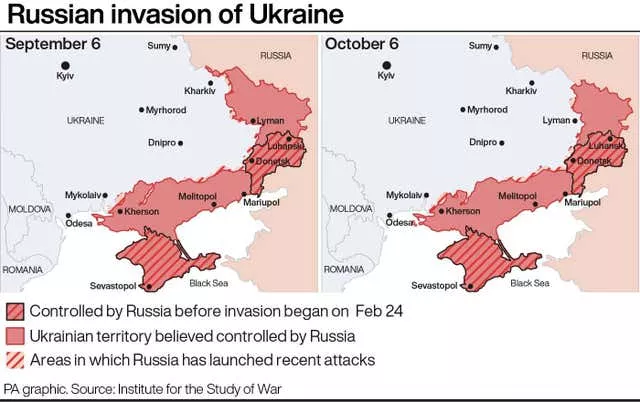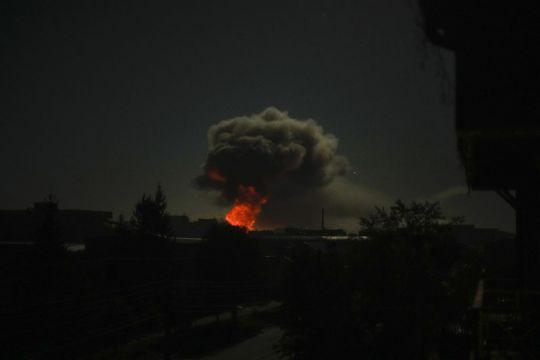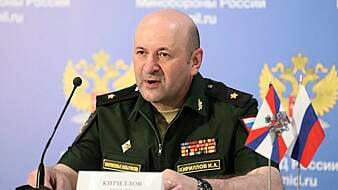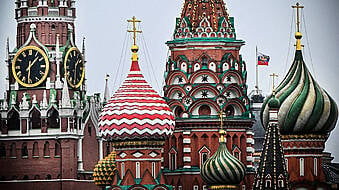A series of explosions has rocked the city of Kharkiv in eastern Ukraine, sending towering plumes of illuminated smoke into the sky and triggering a series of secondary explosions.
There were no immediate reports of casualties.
The blasts early on Saturday came hours after Russia concentrated attacks in its increasingly troubled invasion of Ukraine on areas it illegally annexed, while the death toll from earlier missile strikes on apartment buildings in the southern city of Zaporizhzhia rose to 14.
Kharkiv mayor Ihor Terekhov said on Telegram that the early morning explosions were the result of missile strikes that hit one of the city’s medical institutions, a non-residential building and other spots.

In a rebuke to Russian president Vladimir Putin and his conduct of Europe’s worst armed conflict since the Second World War, the Norwegian Nobel Committee awarded the Nobel Peace Prize to human rights organisations in his country and Ukraine, and to an activist jailed in Russia’s ally Belarus.
Berit Reiss-Andersen, the committee’s chair, said the honour went to “three outstanding champions of human rights, democracy and peaceful co-existence”.
Mr Putin this week illegally claimed four regions of Ukraine as Russian territory, including the Zaporizhzhia region that is home to Europe’s largest nuclear power plant, whose reactors were shut down last month.
Fighting near the Russian-occupied Zaporizhzhia nuclear power plant has alarmed the UN’s atomic energy watchdog, which on Friday doubled to four the number of its inspectors monitoring plant safeguards.
An accident there could release 10 times more potentially lethal radiation than the world’s worst nuclear disaster at Chernobyl in Ukraine 36 years ago, Ukrainian environmental protection minister Ruslan Strilets said on Friday.
“The situation with the occupation, shelling, and mining of the Chernobyl and Zaporizhzhia nuclear power plants by Russian troops is causing consequences that will have a global character,” Strilets told the Associated Press.
The UN watchdog, the International Atomic Energy Agency, reported more trouble at the plant, saying on Friday on Twitter that external power had again been cut off to one of Zaporizhzhia’s shutdown reactors, necessitating the use of emergency back-up diesel generators to run safety systems.
The city of Zaporizhzhia is located 53 kilometres (33 miles) away from the nuclear plant as a crow flies and remains under Ukrainian control.

To cement Russia’s claim to the region, Russian forces bombarded the city with S-300 missiles on Thursday, with more attacks reported on Friday.
Ukrainian authorities said the death toll from the strikes on apartment buildings rose to 14 on Friday, while 12 people wounded in the bombardment remained in hospital.
Missiles also struck the city overnight, wounding one person, Zaporizhzhia governor Oleksandr Starukh said.
Russia also used Iranian-made Shahed-136 drones there for the first time and damaged two infrastructure facilities, he said.
With its army losing ground to a Ukrainian counter-offensive in the south and east, Russia has deployed unmanned, disposable Iranian-made drones that are cheaper and less sophisticated than missiles but can still damage ground targets.
The Washington-based Institute for the Study of War said Russia’s use of the explosives-packed drones was unlikely to affect the course of the war.
“They have used many drones against civilian targets in rear areas, likely hoping to generate nonlinear effects through terror. Such efforts are not succeeding,” analysts at the think tank wrote.
In other Moscow-annexed areas, Russia’s Defence Ministry reported on Friday that its forces had repelled Ukrainian advances near the city of Lyman and retaken three villages elsewhere in the eastern Donetsk region.

The ministry also claimed that Russian forces had prevented Ukrainian troops from advancing on several villages in the southern Kherson region.
Ukrainian president Volodymr Zelenskiy said in his nightly video address on Friday that this week alone, his military has recaptured 776 square kilometres (300 square miles) of territory in the east and 29 settlements, including six in the Luhansk region, which Mr Putin has annexed.
In total, Ukrainian forces have liberated 2,434 square kilometres (940 square miles) of land and 96 settlements since the beginning of its counter-offensive, he said.
In Ukraine’s Dnipropetrovsk region, Russian troops shelled the city of Nikopol overnight, killing one person, wounding another and damaging buildings, natural gas pipelines and electricity systems, the governor reported.
Nikopol lies along the Dnieper River across from Russian-held territory near the nuclear power plant.
The city has been shelled frequently for weeks.
The trail of Russia’s devastation and death from areas where its troops retreated became clearer on Friday.
A report by Ukrainian first deputy minister of internal affairs Yevhen Yenin revealed that 530 bodies of civilians have been found in Ukraine’s north-eastern Kharkiv region since September 7.

The residents killed during the Russian occupation included 257 men, 225 women and 19 children, with 29 people unidentified, Yenin said.
Most of the bodies were found in a previously disclosed mass grave in the city of Izium.
According to Yenin, the recovered bodies bore signs of gunshots, explosions and torture.
Some people had ropes around their necks, hands tied behind their back, bullet wounds to their knees and broken ribs.
Authorities have identified 22 torture sites in parts of the Kharkiv region that Ukrainian forces recently liberated, said Serhiy Bolvinov, a regional police official.
In recently recaptured Lyman, workers found 200 individual graves and a mass grave with an unknown number of victims, Donetsk governor Pavlo Kyrylenko reported on Telegram.
In Sviatohirsk, 24 kilometres (15 miles) from Lyman, 21 bodies of civilians were reburied.







